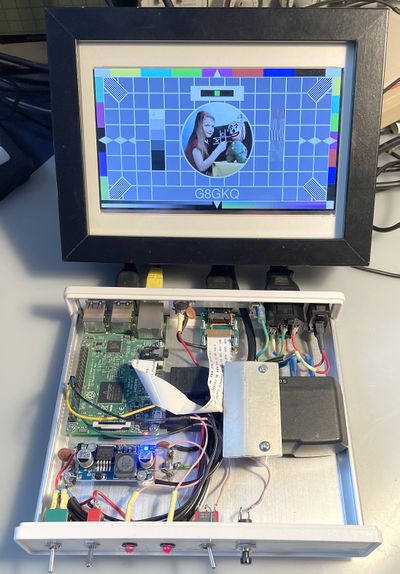Difference between revisions of "BATC HDMI Source"
(Created page with "The BATC HDMI Video source is designed to allow selected WebCams and Raspberry Pi Cameras to be used with HDMI-input video mixers. It also provides a source of HDMI Test card...") |
|||
| Line 2: | Line 2: | ||
[[File:HDMI_Source_1.jpg|400px]] | [[File:HDMI_Source_1.jpg|400px]] | ||
| + | |||
| + | ===Construction=== | ||
| + | |||
| + | The wiring for the HDMI source is very simple; it only requires a switch connected between GPIO pin 16 and ground, and a button connected between GPIO pin 18 and ground. An additional "Active" LED can be wired, with a series resistor, between pin 13 and ground.. A 5.2 volt power supply completes the build. Make sure that you retain access to the HDMI output socket, the LAN port, all 4 USB ports and an extender for the Raspberry Pi Camera ribbon cable if required. | ||
| + | |||
| + | ===Operation=== | ||
| + | |||
| + | On first power-up, make sure that the switch is open (the Test Card position) and that you have the Pi Camera conne | ||
Revision as of 18:39, 11 April 2023
The BATC HDMI Video source is designed to allow selected WebCams and Raspberry Pi Cameras to be used with HDMI-input video mixers. It also provides a source of HDMI Test cards and some HDMI diagnostic information. It is based on a Raspberry Pi 3B, but should work on the Raspberry Pi 2 and 1. It has not been tested on the Raspberry Pi Zero or Raspberry Pi 4.
Construction
The wiring for the HDMI source is very simple; it only requires a switch connected between GPIO pin 16 and ground, and a button connected between GPIO pin 18 and ground. An additional "Active" LED can be wired, with a series resistor, between pin 13 and ground.. A 5.2 volt power supply completes the build. Make sure that you retain access to the HDMI output socket, the LAN port, all 4 USB ports and an extender for the Raspberry Pi Camera ribbon cable if required.
Operation
On first power-up, make sure that the switch is open (the Test Card position) and that you have the Pi Camera conne
